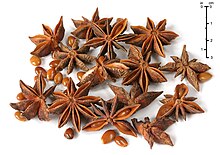Star aniseed
| Illicium verum | |
|---|---|
 |
|
| Star anise fruits and seeds | |
| Scientific classification | |
| Kingdom: | Plantae |
| Clade: | Angiosperms |
| Order: | Austrobaileyales |
| Family: | Schisandraceae |
| Genus: | Illicium |
| Species: | I. verum |
| Binomial name | |
|
Illicium verum Hook.f. |
|
| Synonyms | |
|
|
| Star anise | |||||||||||||||||
| Chinese | 八角 | ||||||||||||||||
|---|---|---|---|---|---|---|---|---|---|---|---|---|---|---|---|---|---|
| Literal meaning | "eight horns" | ||||||||||||||||
|
|||||||||||||||||
| Transcriptions | |
|---|---|
| Standard Mandarin | |
| Hanyu Pinyin | bājiǎo |
| IPA | [pá.tɕjàu] |
| Yue: Cantonese | |
| Jyutping | baat3-gok3 |
| Southern Min | |
| Hokkien POJ | peh-kak |
Illicium verum is a medium-sized evergreen tree native to northeast Vietnam and southwest China. A spice commonly called star anise, staranise, star anise seed, Chinese star anise, or badiam that closely resembles anise in flavor is obtained from the star-shaped pericarp of the fruit of Illicium verum which are harvested just before ripening. Star anise oil is a highly fragrant oil used in cooking, perfumery, soaps, toothpastes, mouthwashes, and skin creams. About 90% of the world's star anise crop is used for extraction of shikimic acid, a chemical intermediate used in the synthesis of oseltamivir.
Illicium comes from the Latin illicio meaning "entice". In Persian, star anise is called bādiyān, hence its French name badiane.
Star anise contains anethole, the same ingredient that gives the unrelated anise its flavor. Recently, star anise has come into use in the West as a less expensive substitute for anise in baking, as well as in liquor production, most distinctively in the production of the liqueur Galliano. It is also used in the production of sambuca, pastis, and many types of absinthe. Star anise enhances the flavour of meat.
It is used as a spice in preparation of biryani and masala chai all over the Indian subcontinent. It is widely used in Chinese cuisine, and in Malay and Indonesian cuisines. It is widely grown for commercial use in China, India, and most other countries in Asia. Star anise is an ingredient of the traditional five-spice powder of Chinese cooking. It is also a major ingredient in the making of phở, a Vietnamese noodle soup.
...
Wikipedia
